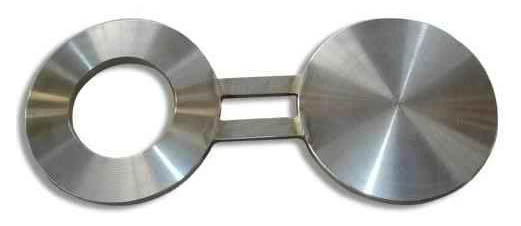Introduction, Processes and Function of Blind Flanges
1. Introduction of blind flanges
Blind flange is a kind of a solid round plate with no center holes but with uniformly distributed bolt holes along the periphery of the plate. It is used for covering or closing the end of a pipe or conveniently cleaning sundries in pipelines for pipeline maintenance. Blind flanges have the same function as shell covers and pipe caps except minor differences—shell covers cannot be disassembled if installed while blind flanges are fastened by bolts and easily dismantled. Sealing faces of blind flanges can be categorized into several kinds: flat face (FF), raised face (RF), male and female face (MFF), ring joint face (RTJ), tongue and groove face (TG), etc. Materials of blind flanges include carbon steel, alloy steel, stainless steel, plastic, copper, aluminum, etc.
2. Categories of blind flanges
From the perspective of appearance, blind flanges can be divided into blind plate flanges, figure 8 blind flanges (also called spectacle blind flanges) as well as paddle blanks and paddle spacers, among which paddle blanks are generally used in conjunction with paddle spacers.
3. Production processes of blind flanges
There are four production processes of blind flanges: striking & forged, cast-forged, medium plate cutting and casting.
4. Function of blind flanges
Blind flanges have the same block-off function as shell covers, pipe caps and welding pipe plugs. Due to good sealing performance, they provide an ideal and reliable solution for the systems requiring complete sealing. Among various kinds of blind flanges, figure 8 blind flanges are shaped like Arabic number 8, with blind plate at one end and restrictor ring at the other end. Restrictor rings have the same diameter as pipelines but has no throttling function. Figure 8 blind flanges are easy to use: when sealing is required, blind plate can be used, while when normal operation is needed, restrictor ring can be used. In addition, restrictor rings can be also used to fill the clearances after mounting blind plates. Blind flanges should not be galvanized when used in systems with oil as medium but should be hot-dip galvanized in systems with other media. The minimum hot dip galvanized coating weight is 610g/m2, based on CB*/Z343 standard.
Blind flange is a kind of a solid round plate with no center holes but with uniformly distributed bolt holes along the periphery of the plate. It is used for covering or closing the end of a pipe or conveniently cleaning sundries in pipelines for pipeline maintenance. Blind flanges have the same function as shell covers and pipe caps except minor differences—shell covers cannot be disassembled if installed while blind flanges are fastened by bolts and easily dismantled. Sealing faces of blind flanges can be categorized into several kinds: flat face (FF), raised face (RF), male and female face (MFF), ring joint face (RTJ), tongue and groove face (TG), etc. Materials of blind flanges include carbon steel, alloy steel, stainless steel, plastic, copper, aluminum, etc.
2. Categories of blind flanges
From the perspective of appearance, blind flanges can be divided into blind plate flanges, figure 8 blind flanges (also called spectacle blind flanges) as well as paddle blanks and paddle spacers, among which paddle blanks are generally used in conjunction with paddle spacers.
3. Production processes of blind flanges
There are four production processes of blind flanges: striking & forged, cast-forged, medium plate cutting and casting.
4. Function of blind flanges
Blind flanges have the same block-off function as shell covers, pipe caps and welding pipe plugs. Due to good sealing performance, they provide an ideal and reliable solution for the systems requiring complete sealing. Among various kinds of blind flanges, figure 8 blind flanges are shaped like Arabic number 8, with blind plate at one end and restrictor ring at the other end. Restrictor rings have the same diameter as pipelines but has no throttling function. Figure 8 blind flanges are easy to use: when sealing is required, blind plate can be used, while when normal operation is needed, restrictor ring can be used. In addition, restrictor rings can be also used to fill the clearances after mounting blind plates. Blind flanges should not be galvanized when used in systems with oil as medium but should be hot-dip galvanized in systems with other media. The minimum hot dip galvanized coating weight is 610g/m2, based on CB*/Z343 standard.

Related News
- Low-Temperature Flange Sealing Solutions for Cryogenic Chemical Pipelines
- Innovative Technology for Automatic Alignment in Underwater Flange Assembly
- Stamped Steel Slip-On Flanges
- Design and Finite Element Analysis of Anchor Flanges for Oil & Gas Pipelines
- Forming and Manufacturing Technology of Anchor Flanges
- Structure and Materials of Anchor Flanges
- Flanges for Pressure Vessels
- An Introduction to Socket Welded Neck Flanges
- Heat Treatment & Mechanical Properties of ASTM A350 LF3 Flanges (Part Two)
- Heat Treatment & Mechanical Properties of ASTM A350 LF3 Flanges (Part One)

